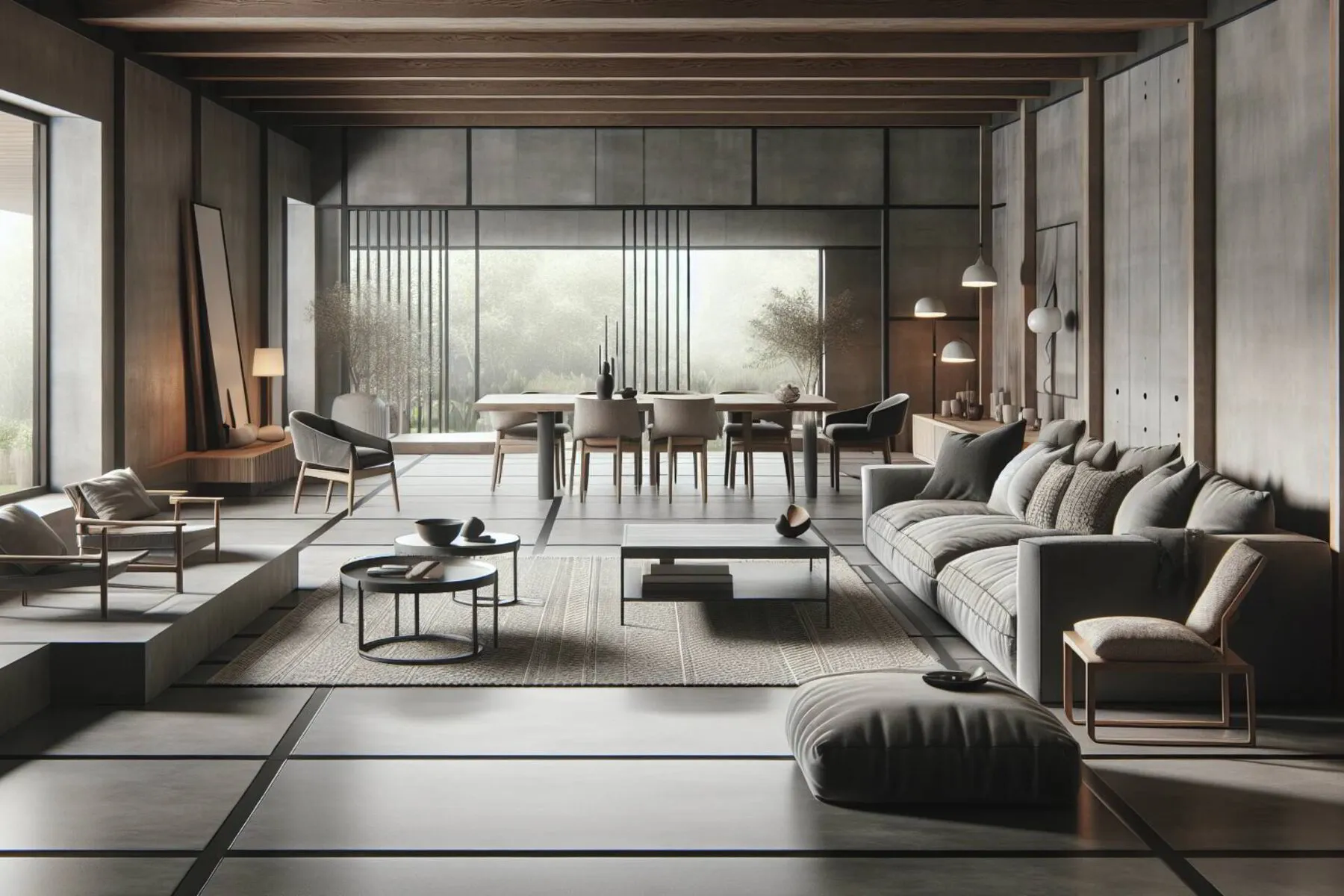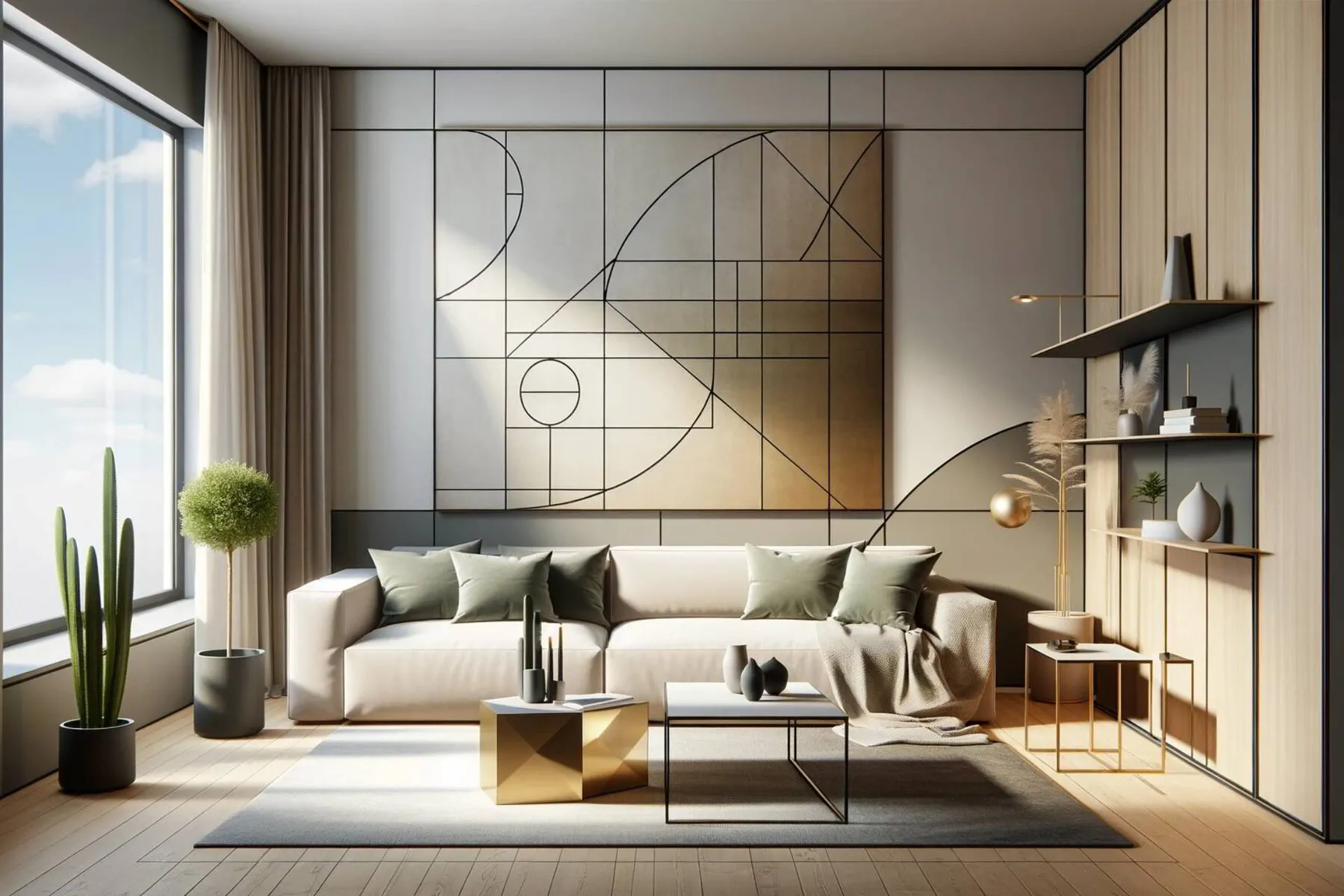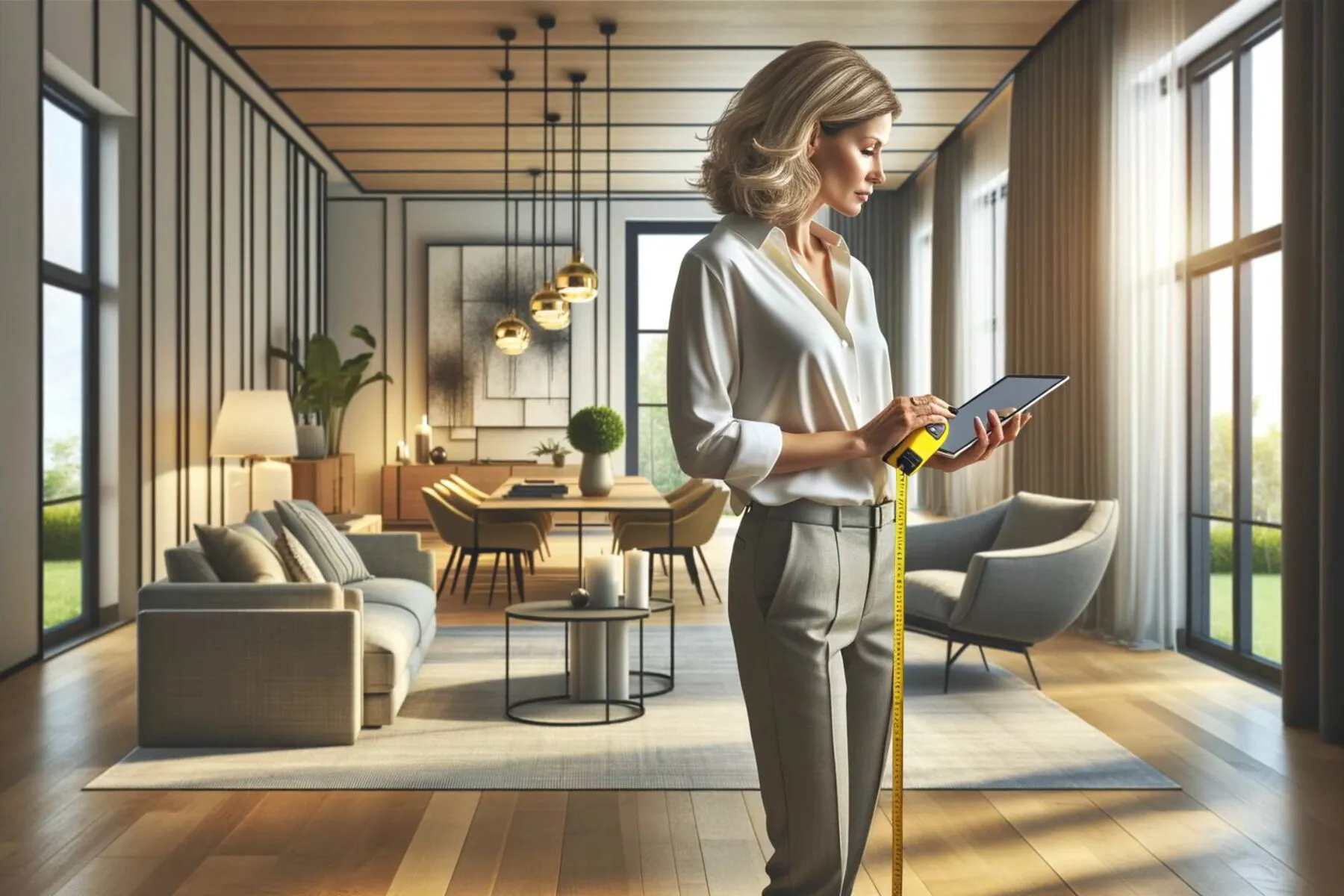Imagine walking into a harmonious, balanced, and visually appealing room. What makes it so? The secret lies in mastering aesthetic balance through the use of how to use proportion and scale in interior design.
By understanding these fundamental concepts, we can create spaces that look stunning and feel comfortable and inviting.
📘 Key Takeaways
- Understanding scale and proportion in interior design is essential for creating balanced, visually harmonious spaces.
- Practical tips include selecting furniture of the correct dimensions, highlighting focal points, embracing negative space, enhancing visual interest with patterns & colors, and applying mathematical principles to create balance.
- Common mistakes should be avoided when implementing these concepts. Accurate measurements are key to achieving a successful design outcome.
Understanding Scale and Proportion in Interior Design
A well-designed space begins with a clear understanding of scale and proportion.
Scale refers to the relationship between an item and the space it occupies.
Proportion is the relationship between different objects in a room, especially in a large room where balance is crucial.
Achieving a perfect balance between scale and proportion results in visually harmonious spaces that effectively use both occupied (positive space) and unoccupied (negative space) areas.
Interior design involves adhering to certain rules. For example, the height of an item must not exceed 13 times that of the item it rests upon. This ensures a balanced look and feel for the room.
Repeating proportions can create a visual rhythm that helps the eye move seamlessly throughout the space and fosters a sense of unity. Grasping these principles allows us to design cohesive, comfortable, and visually engaging interiors.
Defining Scale
In interior design, scale is all about the size of objects in relation to the space they occupy. For example, a large sofa in a small living room may seem overwhelming, while a small chair in a spacious room could appear lost.
By considering the scale of the furniture and other design elements, we can create spaces that feel balanced and inviting.
Accurate measurement of furniture and objects is required to achieve the correct scale. A common oversight made by home decorators is purchasing items based solely on personal preference without considering how they will fit in the room and complement other furnishings.
Ensuring accurate measurements and a wise selection of furniture contributes to a harmonious and visually pleasing room layout.
Defining Proportion
The second key concept in interior design is proportion, which refers to the balance between the size, shape, color, or texture of specific design elements in a space.
Proportion is essential for selecting the appropriate furniture, color scheme, and other home decor pieces, and it plays a crucial role in creating a harmonious and aesthetically pleasing environment.
We can create a balanced and harmonious design by considering the relationship between the various elements within a space, such as furniture, accessories, and architectural features.
Implementing proportion principles allows designers to create aesthetically pleasing and unified spaces through appropriate object size and placement.
Practical Tips for Implementing Scale and Proportion
To create visually appealing spaces that adhere to the principles of scale and proportion, several practical tips can be employed.
These include selecting furniture with the correct dimensions, highlighting focal points, and taking advantage of negative space. Incorporating these techniques allows us to design rooms that exude balance, harmony, and engagement.
Understanding the positioning of furniture and objects in a room is essential for establishing an interesting scale and proportion.
Architectural detailing, such as molding or a fireplace, can also be used to emphasize a room and serve as a focal point, helping to define the space and provide a reference for scale and proportion.
Carefully considering these elements creates a visually appealing and harmonious layout where all elements shine.
Selecting Furniture with Appropriate Dimensions
Choosing furniture with appropriate dimensions is crucial for creating a balanced and visually appealing space. The size of furniture plays an important role in determining the overall aesthetics of a room.
For instance, a large dining room table may feel overpowering in a small dining room, while a small coffee table could get lost in a larger room. Selecting the right dining table for your space is essential to avoid such issues.
To achieve balance with large and small furniture items, it is recommended to disperse the larger items throughout the space and mix them with smaller items.
Clustering all the larger items together should be avoided as this can detract from the visual harmony of the room.
Choosing furniture with suitable dimensions contributes to a cohesive, visually pleasing aesthetic that complements the room’s size and other design elements.
Utilizing Focal Points
Focal points play a critical role in the scale and proportion of a room by drawing attention and creating balance.
By selecting a focal point and arranging the space around it, one can achieve cohesion and set the atmosphere of the area. Moreover, scale can be used to emphasize focal points and direct the eye toward them.
Some effective focal points in interior design may include:
- A fireplace
- A large piece of artwork
- A statement piece of furniture
- A dramatic light fixture
- A feature wall with bold wallpaper or a different paint color
Incorporating focal points into the design results in a visually appealing, balanced space that naturally connects all the elements in the room.
Embracing Negative Space
Negative space, sometimes referred to as white space, in interior design is the empty space between objects, furniture, or walls, which serves to highlight the objects in a room.
Utilizing negative space can provide breathing room, balance, and visual rest to the overall composition, making the positive elements stand out while preventing the design from appearing overwhelming.
Incorporating negative space into a room can be achieved in a few ways, such as:
- Decluttering and removing any superfluous items
- Intentionally leaving empty spaces.
- Utilizing the negative space to create a sense of flow
- Embracing the void in the design
Embracing negative space results in a balanced and comfortable interior design scheme, especially in small spaces.
📘 Related Reading: The Benefits of Good Space Planning in Interior Design
Enhancing Visual Interest with Patterns and Colors
Patterns and colors hold great importance in interior design as they add visual interest, depth, and dimension to a space.
They can also create a harmonious and aesthetically pleasing environment while highlighting specific elements and fostering a sense of balance and cohesion within the overall design.
Some effective strategies for selecting pattern sizes include:
- Incorporating various sizes
- Considering the pattern scale
- Mixing patterns in the same color family
- Utilizing three to five different patterns.
Additionally, the psychological effects of colors in interior design can be significant, as warmer hues can generate a welcoming ambiance, while cooler shades can encourage a sense of tranquility.
📘 Related Reading: The Impact of Pattern In Interior Design
Choosing Pattern Sizes
Selecting suitable pattern sizes is essential for upholding proportion and balance, with smaller patterns better suited for smaller spaces and larger patterns for larger spaces.
For instance, a large pattern may overwhelm a small room, while a smaller pattern may appear lost in a larger space.
It is important to consider the space's scale and proportion to determine the correct pattern size for a room in interior design.
Repeating patterns and shapes and scaling design elements to the room’s ceiling height can help create a cohesive look.
By considering the size of the room and selecting appropriate patterns, we can create visually appealing and balanced designs.
Balancing Color Proportions
Balancing color proportions in a space is crucial for creating a cohesive and visually appealing design.
One strategy to achieve a balanced color proportion is to use the 60-30-10 rule, which involves dedicating 60% of the color to the walls, 30% to furniture, and 10% to accents. This helps to create a balanced color scheme in the room.
In addition to the 60-30-10 rule, incorporating complementary colors, which are colors that are opposite each other on the color wheel, can help create a dynamic and harmonious color scheme.
By considering these strategies, we can create spaces that are not only visually balanced but also aesthetically pleasing.
📘 Related Reading: How To Use Color Theory For Interior Design
Applying Mathematical Principles in Design
Mathematical principles, such as the golden ratio and the rule of thirds, play a significant role in interior design.
These principles help create balance and harmony in our spaces, providing a sense of order and visual interest that is both pleasing and functional to the eye.
Understanding and applying these mathematical principles helps us create visually appealing spaces, adhere to scale and proportion principles, and ensure a harmonious, comfortable, and engaging environment.
The Golden Ratio
The golden ratio, also known as the divine proportion, is a mathematical formula that can be applied to interior design to create visually pleasing proportions and balance in a space. The golden ratio is roughly 1:1.618, which is widely accepted as the most aesthetically pleasing ratio for objects.
Designers utilize the golden ratio in interior design by dividing the space into two sections, with furniture occupying the larger portion to define its purpose and other uses occupying the smaller portion.
Applying the golden ratio creates a sense of harmony and cohesion in our spaces, resulting in a visually appealing and balanced composition.
The Rule of Thirds
The rule of thirds is a design principle that involves visually dividing a space or a wall into thirds, both vertically and horizontally, in order to create balance and visual interest in the design. Elements or objects can be placed along these dividing lines to achieve this effect.
Applying the rule of thirds in interior design results in a visually balanced and aesthetically pleasing composition, enhancing our spaces' overall appeal and harmony.
This principle allows for creating interesting and engaging designs that adhere to the principles of scale and proportion, ensuring a comfortable and inviting environment.
Common Mistakes to Avoid and Solutions
It is not uncommon for homeowners and even professional designers to make mistakes regarding scale and proportion in interior design.
Some common errors include:
- Mismatching furniture
- Hanging wall art too high or too low
- Selecting furniture that is not the correct size for the space
- Failing to achieve the right balance between various elements
Rectifying these mistakes involves:
- Taking accurate measurements
- Experimenting with different layouts
- Decluttering to create a more balanced space
- Considering room size when selecting appropriately scaled furniture
- Maintaining consistency in design elements such as color, texture, and style
We can create visually appealing and harmonious spaces by avoiding these common pitfalls and implementing the right solutions.
Ignoring Room Architecture
Ignoring room architecture can lead to imbalanced designs and a lack of harmony in a space. The architecture of a room, such as its size, shape, and unique features, serves as the basis for establishing the appropriate scale and proportion of furniture and decor.
Successful interior design requires consideration of a room’s architectural elements when selecting and arranging furniture and decor. By working with interior designers and the existing room architecture, we can create visually appealing and harmonious spaces that make the most of the room’s structure and features.
Inaccurate Measurements
Inaccurate measurements can result in poorly scaled and proportioned spaces, lacking harmony and visual appeal.
Ensuring that furniture and design elements are measured accurately before placing them in a room is essential for creating a balanced and visually pleasing environment.
Proper measuring tools, such as measuring tape, laser distance measurers, and digital calipers, are necessary to avoid the consequences of inaccurate measurements. By taking accurate measurements, we can ensure that our spaces are well-proportioned and visually engaging.
Summary
In conclusion, mastering the principles of scale and proportion in interior design is essential for creating visually appealing and harmonious spaces.
By understanding and applying these concepts, practical tips, and strategies, we can craft rooms that look stunning and feel comfortable, and inviting.
So, let’s embrace the power of scale and proportion in our interior designs and transform our spaces into well-balanced, visually engaging havens.
📘 Related Reading: Top 30 Home Interior Design Ideas For A Fresh Look
Lara Harding
Lara is a supporting author @ DIY Home Comfort. She's an experienced interior designer and decorator and a full-time mom. You can find out more about her here.
Frequently Asked Questions
What is an example of scale and proportion in design?
An example of scale and proportion in design is using a smaller or larger size to create an effect, such as making one eye of a cartoon figure twice as large as the other. Proportion can also be seen in the relative size of components that compose an object, like a person's face, where the eye should be smaller than the face, or a male's shoulders being wider than hips.
How is proportion used with scale?
Proportion is used with scale to accurately depict or distract from an ideal in design and artwork. Proportion refers to the size of the parts of an object, while the scale is the size of one object compared to the others.
What is a scale drawing in interior design?
Scale drawing in interior design is a drawing that accurately depicts an object's size with a certain amount of enlargement or reduction. Floor plans are scale drawings showing the relationships between rooms, spaces, and physical features at one level of a structure.
How can I ensure that my furniture is the right size for my room?
Ensure the right size furniture for your room by measuring accurately and choosing pieces that are proportional to the size of the room and other furniture in it.
What is the golden ratio in interior design?
The golden ratio, also known as the divine proportion, is a mathematical formula applied in interior design to create aesthetically pleasing proportions and balance. It is roughly calculated at 1:1.618.







